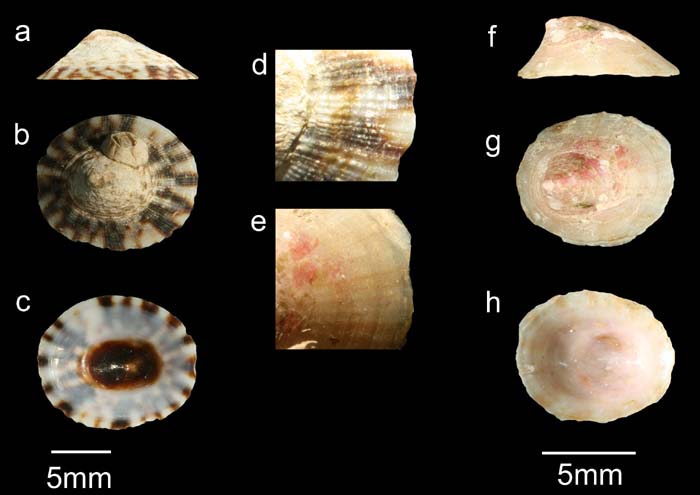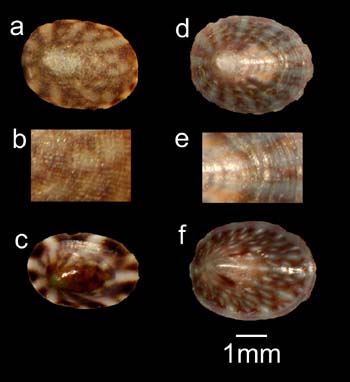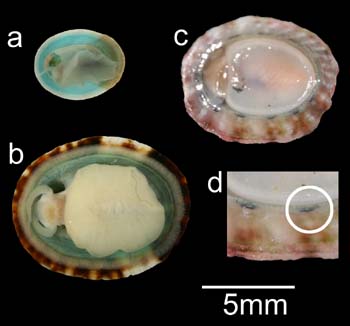There are two species of Tectura which occur around the British and Irish coastline – Tectura testudinalis (Tortoiseshell limpet) and T. virginea (White tortoiseshell limpet). What makes them particularly interesting at the moment is that T. testudinalis has a northerly distribution and, given the likely impacts of climate change, it is expected that the distribution of this species will gradually retreat to the north of Scotland. Indeed a recent article in British Wildlife (Mieszkowska 2009) suggested that it “is now only found in reasonable numbers on the far north coast of Scotland (having disappeared from the Isle of Man and being recorded only rarely in Wales and England), the lack of intertidal habitat further north means the species may soon become extinct in Britain.”
This conclusion is based on the survey of a large number of rocky shores around the UK to look at the distribution of a range of rocky shore species. Figure 1 shows the sites surveyed through the study and highlights those where T. testudinalis was recorded. In short the species was recorded at very few of the sites surveyed.
 |
 |
|
Fig 1. Map showing the sites surveyed as part of the MarClim survey. White squares indicate locations which were surveyed but T. testudinalis was not recorded; red where it was present. Note that the survey was undertaken between 2002 and 2009. Data courtesy of Nova Mieszkowska. |
Fig 2. Distribution of T. testudinalis using data sources which are freely available through the NBN Gateway. White squares indicate records where further checking is required to verify the authenticity of the records. Map includes data from Centre for Environmental Data and Recording, Countryside Council for Wales, Joint Nature Conservation Committee, Conchological Society, Marine Biological Association, Marine Conservation Society, Natural England, Scottish Environment Protection Agency and Scottish Natural Heritage. |
T.testudinalis has a circumpolar distribution. Graham (1988) describes it as being found “only North of a line from Dublin to Anglesey in the Irish Sea and north of Yorkshire in the North Sea and not on the “northern or western Irish Coasts”. However, he does refer to a recent report on the French coast south of the Channel Islands”. Its presence on the Isle of Man was supported by Bruce, Coleman & Jones (1963) who recorded it as “a few at LWS Port Erin Bay, Fleshwick” though “fairly common on stones and shells” in the sublittoral (the Breast, Bay Fine and Port Erin Bay). These records were from 1930-31. On the other hand T. virginea was fairly common below LWM, Port Erin Bay, Port St Mary Ledges and Fleshwick.
On the east coast of England Foster-Smith (2000) notes that T. Testudinalis was recorded from Whitburn in 1858 (there was even some speculation then that it was extending its distribution southwards!). Records in the same area were recorded more recently by the MNCR survey in 1993 who also extended its distribution south to N of Hayburn Wyke (in Scarborough). It is notable that these recent records were made in the sublittoral – not the intertidal.
Combining all the data sources available through the NBN Gateway gives the distribution shown in Fig 2. While the data show a number of records along the south coast these are considered dubious and are shown in white on the map rather than red. They are more likely to be occurrences of T. virginea that have either been misidentified or mis-keyed. The sources of these records are MNCR surveys - JNCC are currently looking into the sources of these more carefully. However, it emphasises a point – that care is needed when separating the two species.
The recent trip to Skye provided a good opportunity to see both species. T. testudinalis was recorded on all of the shores surveyed (six in all) and T. virginea on four. However, it is notable that virtually all of the live T. testudinalis found were relatively small; live animals more than 10mm in length were not noted (though larger fresh dead shells were recorded). This result matches recent observations made in the north of Scotland where again only small individuals were recorded in the intertidal (Mieszkowska pers. comm.) This could indicate that the animals are right at the limit of their tolerance and that slightly harsher conditions (e.g. a particularly hot day) result in mortality of T. testudinalis. However further exploration is really required to identify exactly what aspect controls the southern limit of the species and its precise impact on the species.
Given the expected changes in distribution of T. testudinalis and the recent results of Mieszkowska (2009), records of this species are particularly interesting. Tracking a distribution retreating to the north is much more difficult than range extensions, simply because it is harder to prove a definite absence than it is to record a presence of a species. However, there would definitely seem to be merit in revisiting some of the more southerly sites where T. testudinalis has been previously recorded to see if the species is still there but also observations on the sizes and abundance of the individuals recorded would also be very worthwhile and informative.
Finding and identifying Tectura species
Where to find them
Both species live fairly low on the shore – particularly the less abundant T. testudinalis so a good tide is essential. Both do extend into the sublittoral down to depths of around 50m. They live attached to rock and are generally found in association with red or coralline algae with which they may be well camouflaged so careful searching is often required.
Separating the two species
The diagnostic characteristics separating the two species are reasonably straightforward though a little care is required, particularly for smaller individuals.

Fig 3 Image showing the differences in morphology of adult specimens of T. testudinalis (a - d) and T. virginea (e - h).
a and f: lateral views of species (note that shape is variable with a species and should not be used as an identification feature)
b and g: viewed from above (i.e. exterior of shell)
c and h: interior of shell - note the brown head scar in T. testudinalis
d and e: detail of external sculpturing of shell surface. Note the ridges on T. testudinalis.
Tectura testudinalis
The oval shell is up to about 20mm in length. It is cream in colour with irregular chocolate brown marks radiating from the apex.
Key features:
- Brown head scar within the shell (fig 3c)
- Outer shell surface has fine ridges from the apex down to the shell margin (fig 3d)
- The mantle skirt of the animal is green or blue (fig 4 a-b)
Tectura virginea
The shell is smaller than T. testudinalis growing up to about 10mm in length. It is cream in colour often with pink rays from the apex to the shell margin.
Key features:
- Head scar unpigmented (or exceptionally with a red V-shape) (fig 3h)
- Outer surface of the shell is smooth (fig 3e)
- The mantle skirt of the animal has dark bands aligned with the rays on the shell (fig 4 c-d)
|
|
 |
|
Fig 4 Differences in mantle pigmentation between T. testudinalis (a – b) and T. virginea (c – d). Note the green pigmentation in T. testudinalis (b) which exceptionally can appear blue (a). T. virginea has dark bands on the mantle skirt (highlighted in d). Note that the mantle edge is slightly withdrawn in c and d as a result of the animal being exposed to the air. |
Fig 5 Detail of shell morphology in juvenile specimens of T. testudinalis (a-c) and T. virginea (d-f). Exterior of shell (a, b, d and e) which still displays the ridged sculpturing in T. testudinalis and the interior of the shells (c and f) where the brown head scar of T. testudinalis is again still visible. |

Fig 6: T. testudinalis, Hermsdale (photo: Nova Mieszkowska)
References
Bruce JR, Coleman JS & Jones NS (1963) Marine Fauna of the Isle of Man. Liverpool University Press.
Graham A (1988) Molluscs: Prosobranch and Pyramidellid Gastropods. Synopsis of the British Fauna No. 2.
Foster-Smith J (2000) The Marine Fauna and Flora of the Cullercoats District Volume 2. University of Newcastle Upon Tyne.
Mieszkowska N (2009) Sentinels of climate change – species of the rocky intertidal zone. British Wildlife 20(4) 229-235.

